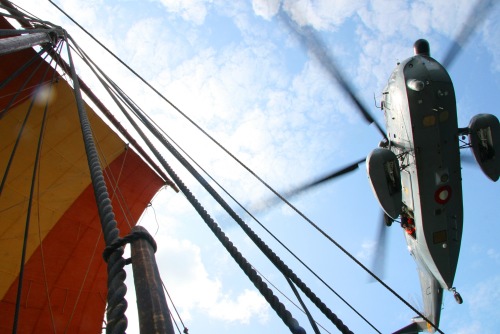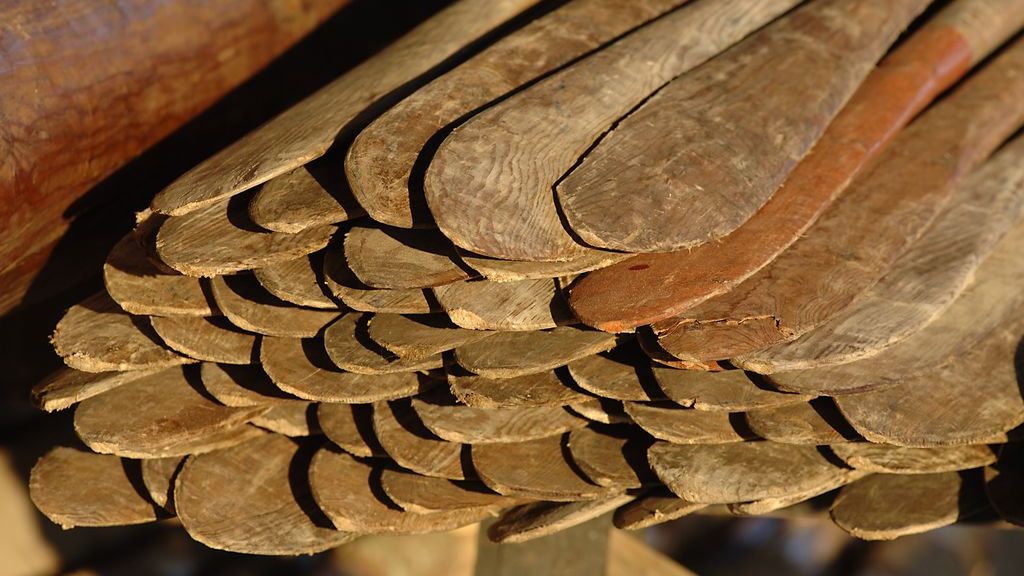During the first weekend of June the Viking Ship Museum in Roskilde held a evacuation drill for the crew members on board the Sea Stallion. The drill took place on Roskilde Fjord on Saturday and on Sunday a rescue helicopter from SOK (The Naval Command) joined to the ship.
The core group of the crew and safety instructor Jan Larsen met at the Viking Ship Museum Saturday morning at 8.30 to go through the last details and at nine the entire crew met to prepare for the drill.
The evacuation drill was arranged to prepare and teach the crew members what to do in case of emergency - they have to learn certain routines already planned, in case of shipwreck or damage were it is necessary to leave the ship.
Two drills on Saturday
The first drill of the day was a so-called evacuation with "dry shoes". That means an evacuation were there's time enough to throw the life rafts into the water and walk on board directly from the ship. An evacuation that could happen if the ship springs a leak and it's impossible to keep the water out. Under circumstances like that the crew will abandon the ship at lee side - the side of the ship in shelter from the wind.
On second drill the crew had to abandon the ship in a hurry. That is necessary if a big wave is causing immediate shipwreck. Under those circumstances the crew abandons the ship and get away from it, as quick as possible, to avoid being pulled under water by the sail, rig or hull. But the crew members still need to be close to the rest of the crew, otherwise they are not able to hold on to each other and seek the life rafts together.
Both drills were satisfactory but they also gave important experience for the final adjustments of the evacuation plan – the portfolio describing the safety procedures on board the Sea Stallion. One important thing to note is that it was difficult to handle the rafts when throwing them into the water. The core group is therefore considering if a pieces of rope would make it easier.
They also learned that only one person needs to hold on the rafts to avoid them from floating away from the Sea Stallion during the evacuation.
The rescue helicopter on Sunday
On Sunday all five of the reconstructed Skuldelev ships sailed out on Roskilde Fjord for a family portrait.
The sun was shinning on all five ships and just when it seemed like the day couldn’t get much better, the Sea stallion was lucky enough to get a visit from a rescue helicopter from the Naval Command. The helicopter was already in the area and the crew on board the Sikorsky-helicopter used the opportunity to practise an evacuation.
They soon realized that it was more difficult than expected. The first time the helicopter moved in on the ship from lee side, but the pilot had to give up. The massive wind pressure from the rotor simply turned the Sea Stallion clockwise and it was impossible for the helicopter crew to lower a line down to the Sea Stallion.
The second time around was successful: 10-15 crew members on board the Sea Stallion rowed and made the ship move forward creating a more stabile position despite the wind pressure from the helicopter. Therefore the helicopter could lower a line with a medic and a doctor on board the Sea Stallion.
When the medic and the doctor returned to the helicopter the crew members on board the Se Stallion set sail and the helicopter ones again tried to move close to the ship - this time from just behind the ship. Surprisingly enough this was the best solution. Unlike the first try the Sea Stallion was stabile in the water this time - and important experience both for the crew on the rescue helicopter and the crew on board the Sea Stallion.
The sail can be dangerous
With it’s thirty metres the Sea Stallion from Glendalough is the biggest reconstruction of the known and notorious Viking warships. The wreck of the original ship was excavated from the bottom of Roskilde Fjord in 1962. Dating of the wood shows that it was build in Dublin in 1042.
Sunday the 1st of July the Sea Stallion and its crew of sixty-five is setting sail for a seven weeks journey from Roskilde and back to the ships original harbour - the Irish capital of Dublin. The purpose it to test the seaworthiness of the Sea Stallion in the rough waters where the original ship sailed a thousand years ago. The route of the journey goes across the North See through the Orkney Islands into the Atlantic and the onwards south to the Irish Sea.
"It’s the first time in a thousand years that a ship this size embarks on journey like that. With a crew from ten different nations and a budget of 25 mio dkr. The test sail writes itself into the history of maritime archaeology as the biggest ever. But safety is more important than scientific tests. It can be quite dangerous to sail an open deck ship in the troubled waters we have to go through. Therefore this weekend was the final exercise of the safety routines that are going to save the crew worst case scenario - if we have to evacuate the ship," says project leader Preben Rather Sørensen.
This was the last time the crew was gathered to sail before the Sea Stallion Sunday the 1st of July 2007 embarks on the sail for Dublin.



